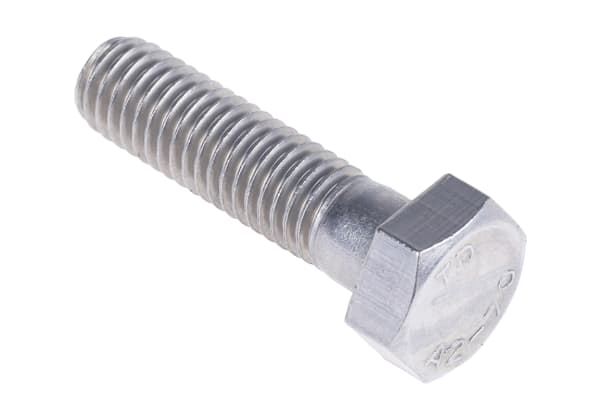- Published 11 Jan 2023
- Last Modified 29 Aug 2023
- 10 min
A Complete Guide to Castor Wheels
Our guide will help you understand what castor wheels are, their uses, how they work, and the types available.

In this introductory guide to common types of castor wheels, we will outline precisely what they are best used for, and how they work in practice. We will also highlight some of the most popular variants you might like to consider for your professional, commercial and industrial needs, and answer some general castor wheel FAQs in the final section of the guide.
What are Castor Wheels?
A castor wheel is a relatively small undriven wheel, meaning that it is free-rolling (as opposed to powered). They are designed to be attached to the bottom of a larger object, to enable easy movement across a floor or other hard surface.
Castor wheels are often referred to simply by the standalone term ‘castors’. They are also commonly identified as ‘caster wheels’ or ‘casters’ by some suppliers and manufacturers. The latter spelling is perfectly valid, although it is largely a US variant. The preferred standard is usually ‘castor’ in the UK.
So, what exactly are castor wheels?
In terms of basic form, there are three main types of castors. They will usually be manufactured in either a single wheel, a double wheel, or a compound wheel configuration:
- A double wheel castor aligns two separate twin wheels side-by-side, for better stability
- Compound castors are two-piece single wheels, made from fixed concentric discs that rotate together around one axis. This can potentially offer greater overall strength in load-bearing applications
Most castor wheels in the UK are relatively simple components. They can be found attached to ‘vehicles’ (typically furniture or basic machinery) in a great many domestic and commercial settings. As a result, many different options and styles are available.
What are Castor Wheels Used for?
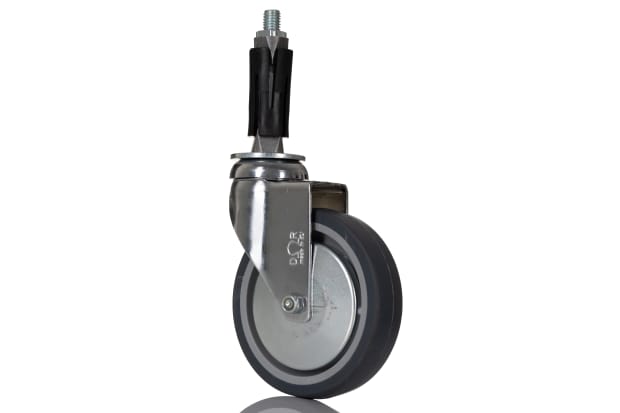
You could technically be asking any of several different questions here. You might mean ‘where would I find them?’, ‘what do they do?’, ‘how do caster wheels work?’, ‘how do I attach castors?’, or ‘are there better alternatives available?’.
We will address the basics of how castors work in a later section. For now, let’s give a quick rundown of their main uses in various commercial, professional and industrial workplaces.
Most castors are used simply to make a heavy or cumbersome piece of furniture or machinery - the ‘vehicle’ - easier to move. Affixing small, unobtrusive wheels to the bottom of any large or bulky item is a great way to make it more mobile in certain scenarios.
The type and style of castors you will need for attaching to a given vehicle will depend mainly on two key factors:
Castor Weight Ratings (Load-Bearing)
- First and most crucially, you will need to consider the weight of the item being supported. Castors each come with an individual weight rating
- This can be multiplied by the number of wheels you are using, to arrive at a total load-bearing capacity for your complete arrangement of castors
- Note that the total load-bearing capacity of your castors should always be at least 30% higher than the total weight of the item when fully loaded, to give a sufficient safety margin
Surface Type (for Movement)
- Second, it is important to know the type of surface you will be moving it around on. In most cases, smaller castor wheels are only really suitable for use on fairly flat and smooth surfaces, such as hard or carpeted floors
- For rougher surfaces, you will need a larger diameter (or radius) of wheel, to handle the uneven terrain more comfortably
- Remember that larger wheels will have a knock-on effect on the height of the vehicle above the floor, as well as the rotational space needed if you are using swivel castors
Aesthetics and practicality are also key factors, where large or prominent wheels would be unsightly or too obtrusive.
These basic and cost-effective components are very widely used in all manner of commercial and office applications. A broad range of specialist and heavy-duty castor types are found across countless industrial, manufacturing and service settings. Notable examples might include:
- Commercial and office furniture
- Aircraft assembly
- Car production plants
- Platform trucks
- Workbenches
- Moving and lifting apparatus
- Hospital beds, stretchers and medical castors
- Factory installations and machinery
- Warehousing applications
- Luggage racks
- Shopping trolleys and produce handling equipment
How Do Castors Work?
The way castor wheels work is straightforward enough. In most cases, they are attached to the underside of the vehicle via a fixed top plate, from which the wheel assembly hangs.
A typical method of attachment is to use 3-4 screws or bolts, inserted through the pre-drilled holes in the top plate. Other popular methods of attachment include bolt hole and threaded stem castors. These are often preferred for either practical or aesthetic reasons.
- Bolt hole castors will normally be affixed in one of two ways, either via a threaded bolt or an additional tubular adaptor piece (the latter is especially common for basic, low-cost office furniture)
- Threaded stem castors generally come with the stem part included in the package; this is what you will use to screw directly into the vehicle you are mounting wheels to
The ideal choice of mounting method will again come down to how much weight each castor is expected to carry. Other factors that may influence your choice of mounting system could include the availability of practical mount locations, wheel size, turn/swivel radius of the castors, or how often you are likely to want to move the item around.
For a majority of large and bulky items of furniture or equipment, a common standard is to use at least four castors, one at each corner of the item’s underside. Exceptionally wide, long or heavy items may need more than this. Smaller products designed to be moved in specific ways - certain trolley types, for example - may require fewer.
In terms of the actual wheels themselves, we have already covered the basic single, double and compound castor configurations. However, there are several other important categories, types and features of castor wheels, such as:
- Swivel or fixed castors
- Heavy-duty or extra heavy-duty castor wheels
- Castors with brakes
- Small or hidden castor wheels
- Castors with tyres or other protective characteristics or safety features
Many of the above are designed for improved performance in specific applications, workplaces or environments.
It should also be noted that various hub types are available. For instance, the wheel hub can come with roller bearings, ball bearings, friction bearings, or plain smooth bore. The latter type features no bearings and is suitable for lighter loads.
Types of Castor Wheels
Let’s take a closer look at some of the most popular castor wheel types available.
Heavy-Duty Castor Wheels
There are three different castor wheel strength ratings widely used in the UK and elsewhere. These denote the load-bearing capacity, durability and manoeuvrability required for the weight of the vehicle they are attached to.
How Much Weight can a Castor Wheel Hold?
- Light duty castors typically support weights of up to 75kg
- Medium duty will usually be suitable for loads between 76kg and 140kg
- Heavy-duty and extra heavy-duty castors can often support weights of over 141kg, but always be sure to check the manufacturer guidelines carefully before mounting
Depending on the types of surfaces you are using heavy-duty castor wheels on, you may also wish to shop for pneumatic or puncture-proof models. This is an especially common requirement for many industrial and outdoor applications.
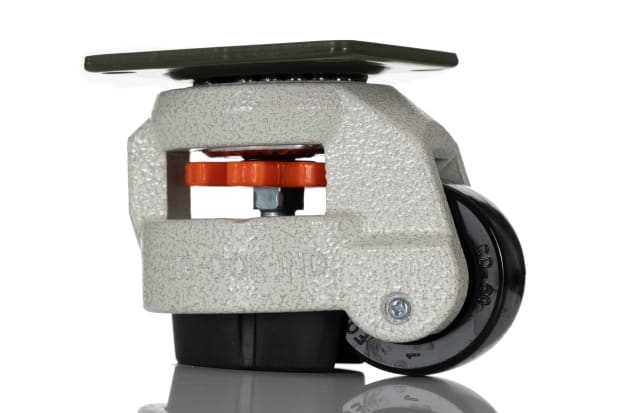
Swivel Castors and Fixed Castor Wheels
Swivel castors allow the wheels themselves to spin on a bearing, meaning they can track across the floor in any direction (as in shopping trolley wheels). Fixed castors only allow the object to move back and forth in a straight/linear manner.
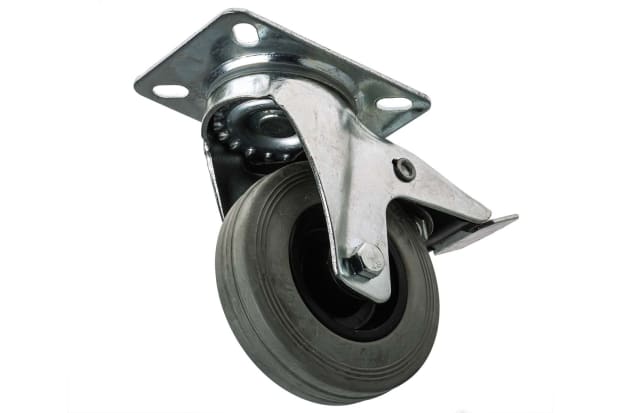
Castor Wheels with Brakes
Braked castors are designed with an integrated pedal or tab mechanism that can lock the wheels in place, securing the object being moved. This is especially useful if you will sometimes need the vehicle to remain fixed in place, without risk of unwanted movement (especially on less even surfaces).
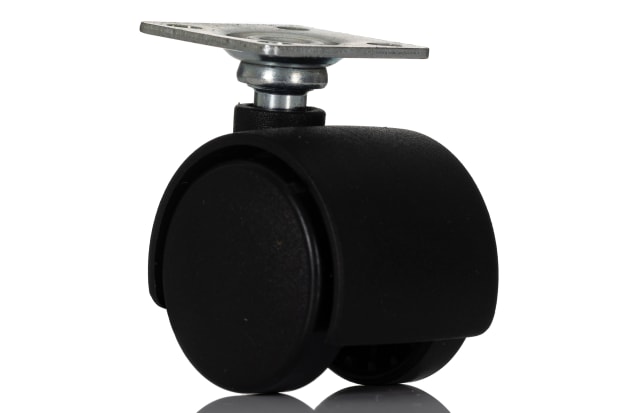
Small Castor Wheels
The size of a castor wheel will usually impact on its maximum stability and load-bearing capacity. Smaller wheels tend to be cheaper and made from less durable materials (although there are exceptions in certain industrial designs).
Most small castors are intended for use in professional or commercial settings. They are often installed on indoor furniture items as they are unobtrusive.
When choosing small castors for indoor use, the general rule of thumb is to choose hard wheels for soft floors, and vice versa. Small hard castors are usually made from plastics like nylon or polyurethane, while small soft wheels will often be rubber or feature a rubber ‘tyre’.
FAQs
What are Castor Wheels Made of?
Common materials used in the manufacture of castors include nylon, polypropylene, various other thermoplastics, rubber, steel, and many more. The decision over which materials to choose for a given application will generally come down to the load-bearing requirements of the job. The types of surfaces you will need to use them on is also an important factor to bear in mind.
Additional materials used to manufacture high-quality castor wheels include:
- Aluminium castors
- Duroplastic
- Elastic
- Iron
- Phenolic resin
- Polyamide castors
- Polychoc
- Polyolefine
- PP
- PUR
How Do You Attach Castors?
The correct way to attach castors depends on the make, model and design of each wheel. As such, there is no single exhaustive guide that covers all wheel types. You will need to pay attention to the manufacturer’s instructions for more detailed guidance.
With that said, the most common type of castor wheel assembly is the standard top plate castor (sometimes called ‘flat-plate’). These typically affix via four screws or bolts that pass through pre-drilled holes in the plate, and into the body of the vehicle.
When mounting your wheels, pay attention to:
- The vehicle surface you are attaching to. It must be structurally rigid and dense enough to support its load across the castor top plates
- Symmetry. No matter how many castors you are using, they must be distributed as evenly as possible around the base of the vehicle. This is key to achieving optimal balance and stability
- Your hole markings. Make these by positioning the top plate in the required location, and marking the location of screw or bolt entries on the surface you are attaching to
- Surface preparation. When driving screws or bolts directly into a piece of furniture or machinery, it is often necessary to drill pilot holes first, to avoid damage and help create a more secure attachment
- Screw and bolt quality. Make sure the fixings you are using will not be an obvious point of weakness. Low-grade, cheap screws and bolts can easily bend or shear under heavy loads
Be sure to test the overall function of the castor wheels (and the manoeuvrability of the vehicle) before putting it into active service.
How Do You Measure Castors?
Accurately measuring castor wheels is essential. To gain a precise measurement, you should measure the width and height of both the top plate and the bolt hole pattern. Make sure to measure from the centre of one hole to the other. Lay the wheel flat to measure the wheel size, taking care to measure over the centre.



